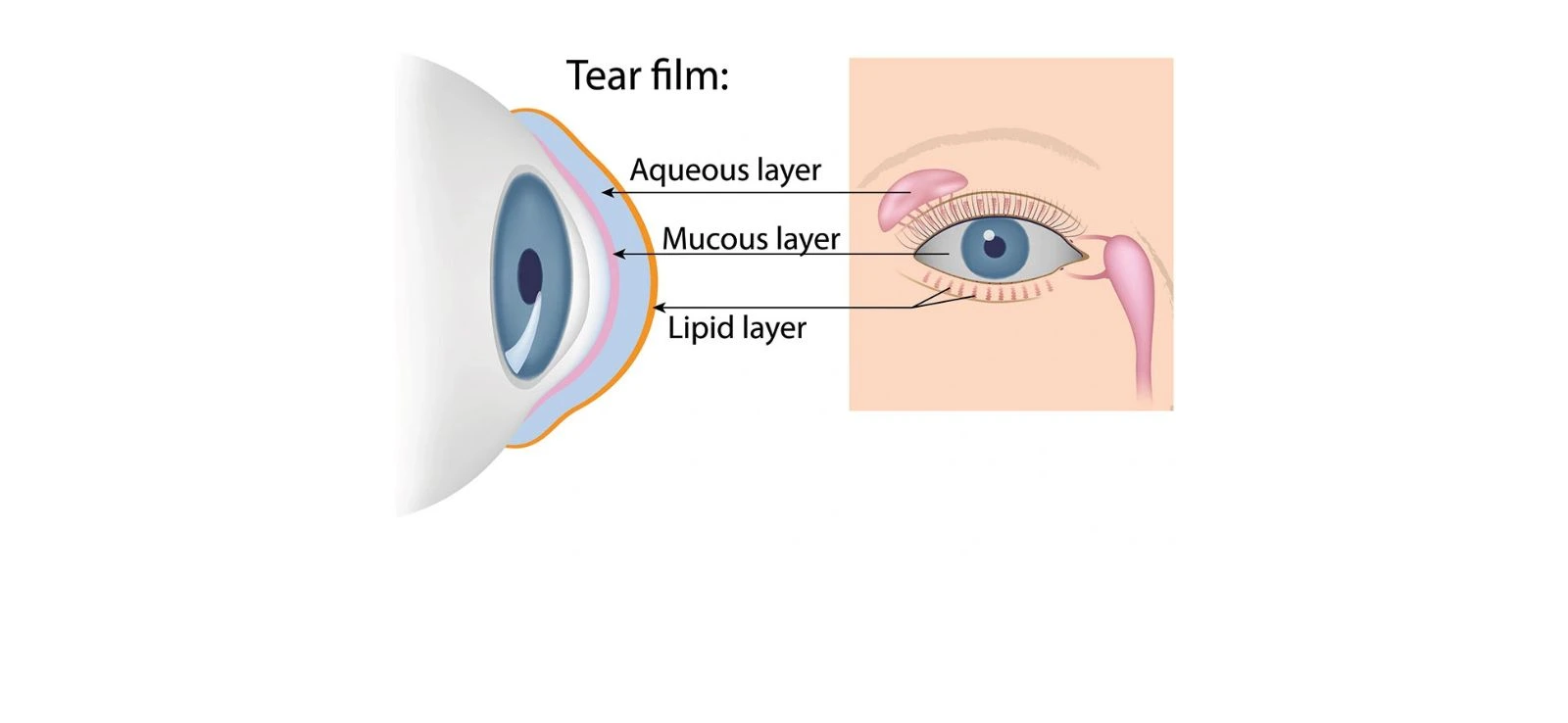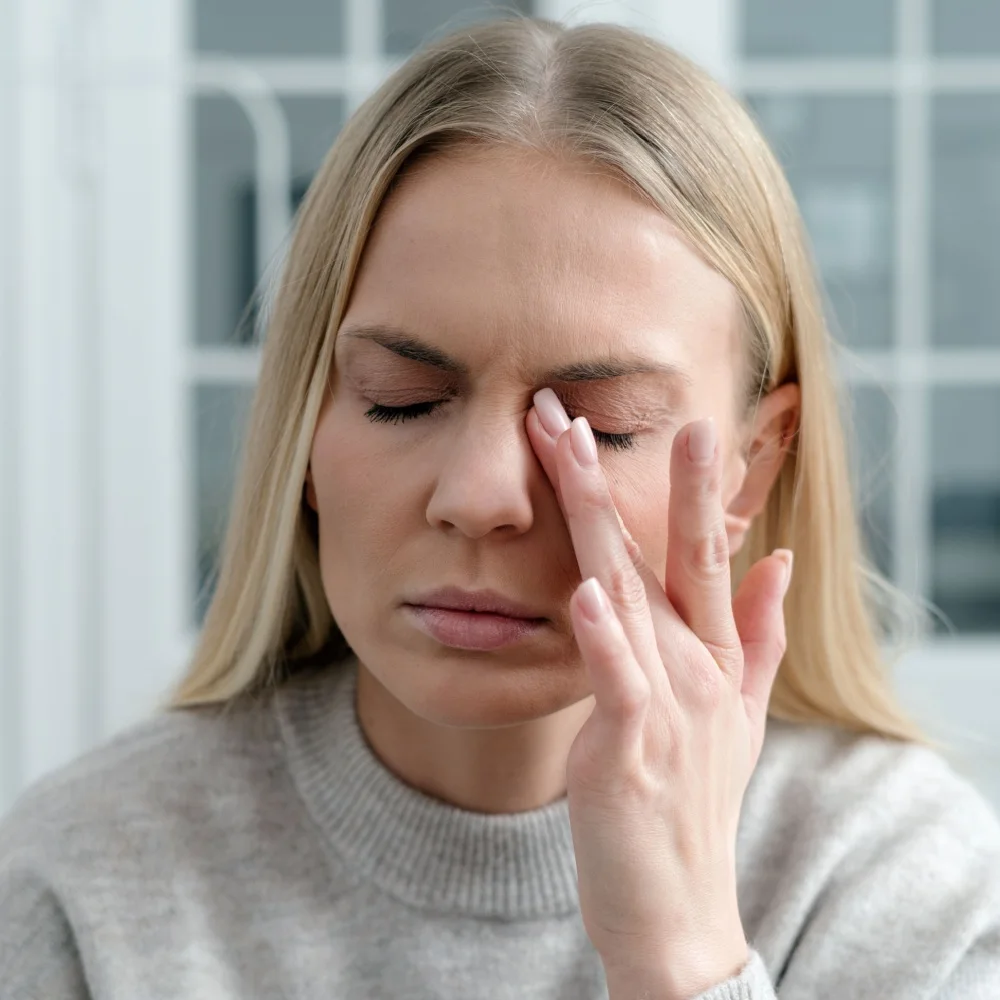Dry Eye
Dry eye syndrome is a prevalent condition affecting up to
Trusted Source
Dry Eye Disease
American Academy of Ophthalmology
Go to Source
20 million
people in the United States, according to the American Academy of Ophthalmology. At NY LASIK, we understand the impact of dry eye on daily life and are committed to providing advanced diagnostic and treatment options. Serving patients in NYC, Manhattan, Brooklyn, and throughout New York, our dedicated team is here to help you find relief and improve your eye health.

What is Dry Eye Syndrome?
Dry eye syndrome, also known as dry eye disease, is a persistent condition resulting from insufficient lubrication of the eyes. While occasional dry eyes can occur due to factors like dehydration, seasonal allergies, or dry environments, dry eye syndrome is a chronic issue. This condition leads to ongoing discomfort and can significantly impact daily activities. Without appropriate treatment, it may cause more severe complications such as pain, ulcers, or even long-term vision problems.

Dry Eye Symptoms
Dry eye syndrome can manifest in various ways, and individuals might not always recognize the condition immediately. Common
Trusted Source
Dry Eyes
Mayo Clinic
Go to Source
symptoms
include:
These symptoms of dry eye disease can also lead to difficulties with daily activities such as reading, watching TV, or driving, and may worsen as the day progresses.
What Causes Dry Eye Syndrome?
The development of dry eye syndrome can have many causes which can include:
- Age: As we age, chronic dry eye is a condition that naturally occurs. Most people over the age 65 will experience some symptoms of dry eyes.
- Gender: Dry eyes is more common in women due to hormonal changes secondary to pregnancy, oral contraceptive or menopause
- Medical Conditions: Chronic dry eye symptoms are more likely to occur in patients who have rheumatoid arthritis, diabetes and thyroid problems. Additionally, if patients have problems with inflammation of the eyelids such as blepharitis, eye surface inflammation or the inward or outward turning of eyelids can cause dry eyes to develop.
- Medications: Certain medicines, including blood pressure medications, antihistamines, decongestants and antidepressants, can cause a decrease in tear production
- Environmental Conditions: An increased rate of tear evaporation can be seen with wind, smoke, and dry climates, all leading to dry eye symptoms. Other factors such as a poor blinking pattern or working on a computer screen for longer durations can cause symptoms.
- Excessive Screen Time: Spending too much time in front of a computer screen, phone screen, or even watching television can contribute to dry eyes.
- Contact Lens: Long-term contact lens wear can also lead to dry eyes.

The Anatomy of Tears: Understanding Tear Production
Every time you blink, your eyes are moisturized and cleansed by a tear film composed of three layers: an oil (lipid) layer, an aqueous layer, and a mucin layer. These layers work together to ensure your eyes remain lubricated and free from debris. For optimal eye health, it’s crucial to maintain a balance between the quantity of tears produced and their quality. Understanding this complex system can help explain the different types of chronic dry eye and their causes.
Types of Dry Eye
Aqueous-Deficient Dry Eye
Aqueous-deficient dry eye arises when there is an insufficient amount of the watery component in tears. This condition can often be managed with over-the-counter artificial tears, which help replenish the eye’s natural moisture.
Evaporative Dry Eye
Evaporative dry eye results from a lack of the oily layer in the tear film. This oil layer is vital for preventing rapid evaporation of the watery layer. Without adequate oil, tears evaporate too quickly, leading to dryness and discomfort.
Meibomian Gland Dysfunction (MGD)
Meibomian gland dysfunction is the most common cause of evaporative dry eye. The meibomian glands, situated in the eyelids, are responsible for producing the oils that form the lipid layer of the tear film. When these glands are blocked, the oil production decreases, leading to faster tear evaporation. Additionally, MGD can cause blepharitis, an inflammatory condition caused by bacteria accumulating on or under the eyelids, further worsening dry eye symptoms.
How is Dry Eye Disease Diagnosed?
At NY LASIK, our experienced doctors utilize a variety of tests during comprehensive eye exams to accurately diagnose dry eye disease. As one of the few practices in the area equipped with advanced diagnostic technology, our eye care team ensures that our patients receive the most precise and effective evaluations. These diagnostic methods include:
- LipiView® II: LipiView® II Ocular Surface Interferometer is a sophisticated diagnostic tool used to measure the thickness of the tear film’s lipid layer with nanometer accuracy. It captures detailed images of meibomian gland structure and analyzes blink patterns to help identify the root causes of dry eye. This advanced technology provides real-time visualization and comprehensive assessments, ensuring precise and effective diagnosis of dry eye
Trusted Source LipiView Interferometer Johnson & Johnson Vision Care Go to Source conditions.
- Tear Osmolarity: This test measures the concentration of salt in a patient’s tears, providing insight into the severity of dry eye.
- Schirmer Test: This test assesses the rate of tear production to determine if the eyes produce an adequate amount of tears.
- Corneal Staining: By applying a special dye, we can examine the cornea and evaluate the quality of the tear film on the surface of the eye.
- Tear Break-Up Test: This test evaluates the stability of the tear film, helping to identify how quickly tears evaporate.
- External Examination: A thorough external exam allows the doctor to assess eyelid structure, blinking patterns, and other factors such as blepharitis that may contribute to dry eye. A magnified view of the eye can provide additional detail of the eyelids and cornea.
- Laboratory Tests: For some patients, dry eye may be linked to underlying medical conditions. Lab tests can help identify these conditions, ensuring accurate diagnosis and effective treatment.

Home Remedies for Dry Eye
For moderate and severe dry eye patients, life can seem like a constant struggle to find even temporary relief. With these patients, their search for relief can have their life revolve around their dry eye treatment regimen. Many will use warm compresses daily, lubricating eye drops every few hours, blinking exercises, and/or lid scrubs. Sometimes they are only able to wear contact lenses for a limited time, if at all. Spending hours on the computer or reading a book may be too painful to even contemplate. If the weather is nice outside, these patients might not be able to enjoy it because their dry eyes are causing too much discomfort.
Professional Dry Eye Treatment
Dry eye related complaints are the number-one reason people make an appointment with an ophthalmologist. Most practices often send the patient away with over-the-counter eye drops, temporarily treating the symptoms but never addressing the underlying cause. The team at NY LASIK has the clinical training and technology necessary to develop an effective dry eye treatment plan for each patient.
Our talented team and center offers the most advanced dry eye treatment options available:
OptiPLUS and OptiLight
At NY LASIK, we offer advanced treatments for dry eye syndrome using OptiPlus and OptiLight technologies. Dr. Minh Vu, the only OD in Manhattan providing these treatments, utilizes OptiPlus, a dual-frequency radiofrequency device that enhances blood circulation and targets the meibomian glands to improve clinical outcomes. OptiLight employs light-based technology to address inflammation caused by meibomian gland dysfunction. This combination offers
Trusted Source
OptiPlus
Lumenis
Go to Source
unmatched
efficacy, promoting both medical and aesthetic
Trusted Source
Multi-Frequency RF Combined with Intense Pulsed Light Improves Signs and Symptoms of Dry Eye Disease Due to Meibomian Gland Dysfunction
Chelnis J, Garcia CN, Hamza H
Go to Source
results
for dry eye patients.
LipiFlow®
The FDA-approved LipiFlow® Activator treats meibomian gland dysfunction (MGD) by using Vectored Thermal Pulse™ (VTP) technology. It delivers controlled heat and gentle pressure to the inner eyelid, effectively removing gland blockages. This treatment targets both eyelids simultaneously and typically requires just one quick session to provide
Trusted Source
A single LipiFlow® Thermal Pulsation System treatment improves meibomian gland function and reduces dry eye symptoms for 9 months
Greiner JV
Go to Source
significant
relief from dry eye symptoms.
Additional treatments for dry eye disease available to our patients include:
- Punctal Plugs
- Allergy Testing
- Amniotic Tissue application for dry eye relief
- Allograft Tissue contact lenses
It might seem contradictory, but dry eye syndrome can lead to excessive watering. When the eyes experience dryness due to poor tear quality or rapid tear evaporation, they often overcompensate by producing more tears.
Insurance coverage for dry eye treatments varies. Some treatments may be covered as dry eye syndrome is a medical condition, but not all treatments are included. During your consultation, we can help clarify your insurance benefits.
Yes, treating dry eye syndrome is crucial. Without proper treatment, it can lead to more severe issues such as corneal damage, recurrent infections, and ulcers. Seeking treatment helps prevent these serious eye health problems.
1 American Academy of Ophthalmology. Dry Eye Disease. Available: https://www.aao.org/eyenet/article/dry-eye-disease. Accessed July 2, 2024.
2 Mayo Clinic. Dry Eyes. Available: https://www.mayoclinic.org/diseases-conditions/dry-eyes/symptoms-causes/syc-20371863. Accessed July 2, 2024.
3 Johnson & Johnson Vision Care. LipiView Interferometer. Available: https://www.jnjvisionpro.ca/products/lipiview-interferom. Accessed July 2, 2024.
4 Lumenis. OptiPlus. Available: https://lumenis.com/vision/products/optiplus/. Accessed July 2, 2024.
5 Chelnis J, Garcia CN, Hamza H. Multi-Frequency RF Combined with Intense Pulsed Light Improves Signs and Symptoms of Dry Eye Disease Due to Meibomian Gland Dysfunction. Clin Ophthalmol. 2023 Oct 20;17:3089-3102. doi: 10.2147/OPTH.S426564. PMID: 37881780; PMCID: PMC10595163. Available: https://pubmed.ncbi.nlm.nih.gov/37881780/. Accessed July 2, 2024.
6 Greiner JV. A single LipiFlow® Thermal Pulsation System treatment improves meibomian gland function and reduces dry eye symptoms for 9 months. Curr Eye Res. 2012 Apr;37(4):272-8. doi: 10.3109/02713683.2011.631721. Epub 2012 Feb 10. PMID: 22324772. Available: 10.3109/02713683.2011.631721. Epub 2012 Feb 10. PMID: 22324772. Available: https://pubmed.ncbi.nlm.nih.gov/22324772/. Accessed July 2, 2024.
Dr. Leonard Bley has either authored or reviewed and approved this content.